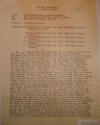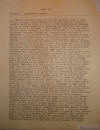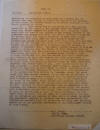|
JICARO, NICARAGUA. 2 November 1927
|
From:
|
Patrol Commander, Quilali
Patrol.
|
|
To:
|
The Commanding Officer, Fifth
Regiment
|
|
Subject:
|
Operations Report.
|
|
Reference:
|
(a) Orders CO 3rd Bn, 5th Regt,
Matagalpa dated 15 Oct 1927.
[b-e:
radio references Oct. 11-15 from
Gulick]
|
 1. In accordance with
reference (a) a patrol consisting of 1
officer, 25 enlisted marines, 1 hospital
corpsman USN, 3 officers and 40 enlisted
Guardia, mounted with a total of 119
animals, left Matagalpa at 1100 on Oct
18, 1927, and camped successfully at the
following places: El Eden, 10 miles N of
Matagalpa on the Jinotega road, Oct 18;
Jinotega, Oct 19; Caso Real, Oct 20;
Embocadero, Oct 21; Guale, Oct 22;
Cierra La Breyera, Oct. 23; Las Piedras,
south of EL Rio Coco and three miles W
of Santa Cruz, Oct 24, at 1130. Oct 24,
plane dropped a letter of instructions
and reconnaissance report. At 1030 Oct
25, cleared Las Piedras, crossing Rio
Coco at point 1000 yards W of Las
Piedras. At 1045, plane dropped modified
letter of instructions also map and
mosaic showing scene of the crash.
Crossed the Jicaro River at 1600
arriving at Cierra La Compana at 1700
where patrol camped for the night. At
0900 Oct 26, cleared Cierra La Compana
arriving at Mata Guineo at 1700 where
patrol camped for the night. Passed
through Quilali at 1300. Sighted planes
at 1045. Requested information as to the
location of the wreck and messages
dropped stating that we were on the
south side of the ravine in which the
plain fell and that we were 2 miles to
the E of it. Left for the scene of the
crash at 1100. Sighted planes at 1400
while on the N side of the ravine headed
W and received information that Lt.
Chappell was being attacked by bandits
to his N and S 3 miles W of our
position. In order to reach Lt. Chappell
it was necessary to cross an almost
impassable ravine. Due to the steep
slope of the ravine it was not crossed
until 1700 at which time all firing had
ceased which made it impossible to
effect a junction with Chappell that
night. It was believed that we were
within 1000 yds NE of Chappell when we
deployed and took position on the ridge
which we believed to be occupied by the
bandits to the N of Chappell. [p. 2]
1. In accordance with
reference (a) a patrol consisting of 1
officer, 25 enlisted marines, 1 hospital
corpsman USN, 3 officers and 40 enlisted
Guardia, mounted with a total of 119
animals, left Matagalpa at 1100 on Oct
18, 1927, and camped successfully at the
following places: El Eden, 10 miles N of
Matagalpa on the Jinotega road, Oct 18;
Jinotega, Oct 19; Caso Real, Oct 20;
Embocadero, Oct 21; Guale, Oct 22;
Cierra La Breyera, Oct. 23; Las Piedras,
south of EL Rio Coco and three miles W
of Santa Cruz, Oct 24, at 1130. Oct 24,
plane dropped a letter of instructions
and reconnaissance report. At 1030 Oct
25, cleared Las Piedras, crossing Rio
Coco at point 1000 yards W of Las
Piedras. At 1045, plane dropped modified
letter of instructions also map and
mosaic showing scene of the crash.
Crossed the Jicaro River at 1600
arriving at Cierra La Compana at 1700
where patrol camped for the night. At
0900 Oct 26, cleared Cierra La Compana
arriving at Mata Guineo at 1700 where
patrol camped for the night. Passed
through Quilali at 1300. Sighted planes
at 1045. Requested information as to the
location of the wreck and messages
dropped stating that we were on the
south side of the ravine in which the
plain fell and that we were 2 miles to
the E of it. Left for the scene of the
crash at 1100. Sighted planes at 1400
while on the N side of the ravine headed
W and received information that Lt.
Chappell was being attacked by bandits
to his N and S 3 miles W of our
position. In order to reach Lt. Chappell
it was necessary to cross an almost
impassable ravine. Due to the steep
slope of the ravine it was not crossed
until 1700 at which time all firing had
ceased which made it impossible to
effect a junction with Chappell that
night. It was believed that we were
within 1000 yds NE of Chappell when we
deployed and took position on the ridge
which we believed to be occupied by the
bandits to the N of Chappell. [p. 2]
 At
0930 the following day, we left the
position that we held during the night
and proceeded in the direction of
Chappell's position arriving there at
1300. At 0930 plane dropped message
giving the exact location of Chappell
and advising that Lt. Chappell would be
informed of the probable time of our
arrival. The mountains, ravines,
and heavy underbrush in the vicinity of
Lt. Chappell's position combined with
the lack of knowledge of the trails made
the junctive [junction] with Chappell a
very trying and difficult task. A task,
which without the aid of the planes,
would have been near to the impossible.
Upon joining Chappell we found that his
animals had not been watered for some
time. A patrol was sent out to cover the
watering of the animals. The patrol was
fired on from to the SE. The bandits
were driven back after a skirmish of not
more than 5 minutes. The combined patrol
remained in the same position during the
following day, Oct 29, to afford the
animals a long needed rest. At 0900, Oct
30, cleared defensive position for the
scene of the wreck, arriving there at
the S side of the ravine, opposite the
field where the plane fell at 1030. The
train under a strong guard was left on
the road S of the ravine and with 50 men
I proceeded to the scene of the wreck
arriving on the field at 1150. Inspected
the plane and found the motor and all
metal parts intact. The machine guns
were missing; also all parts that could
be destroyed by fire. The houses in the
vicinity were searched and found to be
occupied but temporarily deserted.
Planes were sighted at 1030 and at our
request dropped several bombs on the
houses and a banana patch to the N of
the ravine. One plane circled the field
of the crash for about 30 minutes while
we were inspecting the wreck. At 1300 we
rejoined the train and left for the
banks of the Jicaro river. Arriving at a
point 2 miles N of Quilali at 1615 where
we camped for the night. 1000 Oct 31,
cleared hill two miles N of Quilali. At
0630 sent patrol consisting of 1 officer
and 15 men to reconnoiter the E bank of
the Jicaro. This patrol returned and
joined the main body at 1000 after
having searched all houses along its
path and without having encountered
either inhabitants or enemy forces. At
1130 passed thru Quilali where planes
were sighted. At 1700 arrived at
Jicarito where we camped for the night.
Cleared Jicarito 0915 Nov 1; At 1030 Nov
1, we made contact with a bandit force
of about 250 men on the road near
Espino, six miles SE of Jicaro. We
engaged them for 35 minutes. Marine
casualties, one private, suffered slight
injury on left elbow caused by fragment
of dynamite bomb, Guardia casualties,
two privates, both killed by rifle fire.
One mulero was seriously wounded in the
chest by rifle fire. Six mules were
killed by fire on the scene of this
action. The enemy [p. 3] At
0930 the following day, we left the
position that we held during the night
and proceeded in the direction of
Chappell's position arriving there at
1300. At 0930 plane dropped message
giving the exact location of Chappell
and advising that Lt. Chappell would be
informed of the probable time of our
arrival. The mountains, ravines,
and heavy underbrush in the vicinity of
Lt. Chappell's position combined with
the lack of knowledge of the trails made
the junctive [junction] with Chappell a
very trying and difficult task. A task,
which without the aid of the planes,
would have been near to the impossible.
Upon joining Chappell we found that his
animals had not been watered for some
time. A patrol was sent out to cover the
watering of the animals. The patrol was
fired on from to the SE. The bandits
were driven back after a skirmish of not
more than 5 minutes. The combined patrol
remained in the same position during the
following day, Oct 29, to afford the
animals a long needed rest. At 0900, Oct
30, cleared defensive position for the
scene of the wreck, arriving there at
the S side of the ravine, opposite the
field where the plane fell at 1030. The
train under a strong guard was left on
the road S of the ravine and with 50 men
I proceeded to the scene of the wreck
arriving on the field at 1150. Inspected
the plane and found the motor and all
metal parts intact. The machine guns
were missing; also all parts that could
be destroyed by fire. The houses in the
vicinity were searched and found to be
occupied but temporarily deserted.
Planes were sighted at 1030 and at our
request dropped several bombs on the
houses and a banana patch to the N of
the ravine. One plane circled the field
of the crash for about 30 minutes while
we were inspecting the wreck. At 1300 we
rejoined the train and left for the
banks of the Jicaro river. Arriving at a
point 2 miles N of Quilali at 1615 where
we camped for the night. 1000 Oct 31,
cleared hill two miles N of Quilali. At
0630 sent patrol consisting of 1 officer
and 15 men to reconnoiter the E bank of
the Jicaro. This patrol returned and
joined the main body at 1000 after
having searched all houses along its
path and without having encountered
either inhabitants or enemy forces. At
1130 passed thru Quilali where planes
were sighted. At 1700 arrived at
Jicarito where we camped for the night.
Cleared Jicarito 0915 Nov 1; At 1030 Nov
1, we made contact with a bandit force
of about 250 men on the road near
Espino, six miles SE of Jicaro. We
engaged them for 35 minutes. Marine
casualties, one private, suffered slight
injury on left elbow caused by fragment
of dynamite bomb, Guardia casualties,
two privates, both killed by rifle fire.
One mulero was seriously wounded in the
chest by rifle fire. Six mules were
killed by fire on the scene of this
action. The enemy [p. 3]
 casualties are
estimated at 60 dead and wounded. The 2
Guardia dead were brought to Jicaro and
buried in the cemetery at that place.
The wounded mulero is receiving
treatment in the Marine Hospital at
Jicaro. casualties are
estimated at 60 dead and wounded. The 2
Guardia dead were brought to Jicaro and
buried in the cemetery at that place.
The wounded mulero is receiving
treatment in the Marine Hospital at
Jicaro.
2. This attack was of the nature of a
well planned ambush but it fell short of
the success which the bandits had hoped
for, first; because the main body took a
slightly higher trail than the bandits
had planned on and second, because of
the promptness and energy with which our
forces returned a withering and accurate
fire. The bandits attempted to hold
their places both with their rifle and
with dynamite bombs but our grenades and
rifles dislodged them after which they
were followed up with all the weapons
with which we were armed. One of the
bandits killed was identified as Morsal
Solar of Jimyco, a colonel in Sandino's
band. The number of enemy engaged in
this action is estimated from the volume
of their fire and from the front over
which they were deployed. At a point
about 3 miles from Jicaro the point of
the advanced guard located a group of
about 12 men in a position behind logs
with a Lewis Gun, at a distance of about
150 yards ahead. A short skirmish
brushed away this group with no known
casualties on either side. The patrol
arrived at Jicaro at 1600. Every effort
has been made by this patrol to obtain
information as to the fate of the lost
aviators. No inhabitants were
encountered in the entire area from
Quilali to Jicarito, except the armed
bands with whom we made contact. In no
case was it possible to take prisoners.
It is not believed that the missing
aviators made a stand or engaged in a
fight in any of the houses near the
scene of the crash. These houses were
examined carefully for signs of a stand
and for bullet holes but none were
found. In every instance of action and
every case of obstacles to be overcome,
the Guardia attached to my command
fought and worked with outstanding
courage and energy. They proved
themselves cheerful and willing in face
of trying hardships and were ever eager
to close with the enemy when
encountered. Throughout the movements
and actions of this patrol in enemy
territory the assistance rendered by
aviation has been invaluable. The
information received from the planes was
in every case accurate, useful and of
the greatest importance to the
intelligent conduct of this patrol.
- - - M. J. Gould. - - - - - - - - - - -
- - - - -
1st Lt. USMC.
Commanding Quilali Patrol.
NA127/43A/3
|

